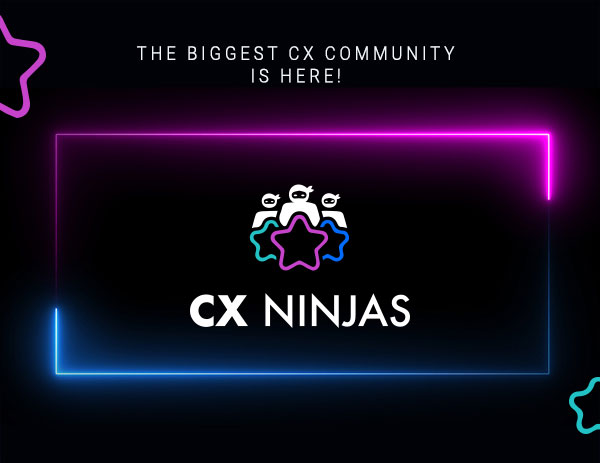As the Digital Era keeps pushing us away from the traditional product-oriented models to customer-driven business approaches, Customer Experience (CX) grows into a key factor for business growth and success. Whether beginners or CX professionals, this is a glossary with all the terms that you will be needing along with the implementation of the right CX journey for your customers.
So let’s get started!
Artificial Intelligence (AI)
The most important AI technologies for assessing customer feedback fall in the area of natural language processing (NLP) and machine learning. Both groups of technologies can be utilized to make analytics more actionable.
B2B Customer Experience
Is, simply put, the experience and interactions with your company of a B2B customer; B2B moves towards personalized omnichannel experience in B2B customer journeys, with the majority of B2B buyers now expect the same buying experience as B2C.
B2C Customer Experience
Refers to how a B2C customer perceives his buying experience and further interactions with your company. Same as with B2B customers, B2C customers expect consistent and personalized omnichannel experience.
Brand experience
Is how you design, see and want your customer experience to be. Brand experience is a very close concept to customer experience, except the latter refers to how customers reflect on your company.
Customer Churn
Happens when a customer/subscriber stops doing business with a company. Customer churn is a critical metric because it is much less expensive to retain existing customers than it is to acquire new customers and the optimal way to reduce customer churn is to improve customer experience.
Customer centricity
Refers to customer-oriented culture in the company. The essentials include the shared targets, shared understanding and the voice of the customer program implemented across the organization.
Customer-centric
Transformation consists of 5 steps: Securing the executive support, Building a cross-functional CX team, Creating a shared understanding, Involving all the employees in the transformation and building CX into the culture.
Customer Experience
Refers to how customers perceive their interactions with your company. Customer experience is constructed in direct or indirect interaction with your company but it always involves the subjective response of the customer. Therefore, you can never fully determine it.
Customer Experience Management (CEM, CXM)
Is tracking and understanding your customers’ experience, acting on that understanding and closing the loop with the customer. Gartner defines it as “the practice of designing and reacting to customer interactions to meet or exceed customer expectations and, thus, increase customer satisfaction, loyalty and advocacy“.
Customer Satisfaction, or CSAT
Is a broad term that describes many different types of customer surveys. The surveys are usually sent to customers shortly after an interaction with a company is complete, for example, after a customer has contacted customer support. This type of survey is a great way to close the loop on customer interaction and make sure that you’ve met their expectations.
Customer service, or customer support
Is often mixed up with customer experience. Although both concepts are related to customers, customer service is just a part of the customer experience. Customer service is the actual assistance or advice provided by the company to people, who want to use or are already using the product/service.
Customer feedback
Is customers’ opinion about your product. Customer feedback helps you understand what drives your customer satisfaction rates (or impact factors*), and simultaneously, understand revenue drivers.
A customer journey
Is a complete individual experience with your brand. The journey includes all the touchpoints and engagements that an individual has with a brand, spanning a variety of touchpoints by which the customer moves from awareness to engagement and purchase.
A customer journey map
Is a visual representation of every interaction and activity a single customer might have with your brand. It gets complex because there are multiple channels and ways customers might come to your brand. No doubt you want to make every customer experience as great as possible.
Customer Lifecycle
Is the process that every customer goes through: from considering, purchasing, and using to maintaining loyalty to a product or service. Unlike a customer journey, which is a unique journey of an individual customer, a customer lifecycle is a process driven by a company. Multiple customer journeys can relate to the same customer lifecycle.
Customer metrics
Are simply measurements used to gauge the customer – whether for loyalty and retention, marketing, or new product development. In customer experience, that means a measurement of the customer satisfaction and business value of customer experience development. Customer metrics are also referred to as customer experience KPIs.
Net Promoter Score (NPS)
Is a numerical part of the Net Promoter System, customer metric. It is calculated with the key question “How likely is it that you would recommend [your brand] to a friend or colleague?” using a 0-10 scale.
Net Promoter System (NPS)
Consists of the Net Promoter Score and open text feedback; it’s short and simple, yet provides all the information you need to proceed with customer experience.NPS typically has a very high correlation with retention: the happier the customer, the more loyal they are, and therefore the more revenue they generate for you during their customer lifetime.
Omnichannel
Is a cross-channel sales approach that provides the customer with an integrated customer experience. Omnichannel offers a consistent, personalized experience for consumers across all channels and devices with the main goal to make the customer journey as easy as possible, and that means consistent engagement no matter where or how they interact with you.
Onboarding
Is familiarizing a new customer with the service. Often, we relate the onboarding with SaaS companies, when talking about onboarding, but it’s not a necessity. In the SaaS business, however, onboarding has become a very usual practice. It warms up the relationship between your brand and the new user, yet at the same time educates them and increases engagement. A user, who has gone through a thoroughly-planned and beautifully-designed onboarding process is more likely to stay and become a loyal customer.
Personalization
Means providing a customer experience that is tailored to the individual’s consumer preferences and specific needs. Personalization comes in all forms and shapes: targeted advertising, tailored solutions.
Customer retention
Is the measurement of how a business retains customers over a specific period of time. High retention rates are what you should aim at since retaining customers costs less than acquiring them.
Social Media
Is a powerful tool when it comes to customer experience, while social media could not only be used for customer support, but should be used to actively advocate your brand. After all, a satisfied customer is the best advertising you can have.
Text Analytics (text mining)
Includes a set of techniques that structure information arriving in text format— for instance free text customer feedback. The purpose is to convert unstructured text into meaningful structured data to support business analysis and decision-making. Topic analysis reveals topics that are most talked about.
Customer touchpoint
Is any interaction a customer has with your company. Touchpoints are not channels, but rather each individual activity of a customer. Touchpoints are also what a customer journey consists of.
Voice of customer (VoC)
Refers to customers’ feedback about their experiences with and expectations for your products or services. Voice of customer is not only about how to gather the customers’ feedback, but how to analyze and most importantly, act on the feedback. Voice of Customer should be involved in a systematic process of customer experience development in your company. The process consists of five steps: collect, analyze, act, close the loop and set targets, a process that, when done properly, will help you to hear your customer, act on customer feedback and improve customer experience in a consistent sustainable way.

